1350 Square Feet House Design Drawing
Architects in Bangalore Architects4Design.com
We are a team of young leading Architects in Bangalore who have come together to establish Archietcts4Design.com to cater to the demands of today's construction-related services.
 As residential architects, we understand many difficulties in starting any Construction or Design related works, so we decided to simplify things for our clients. Hence, we started this Architectural firm Architects4Design.com to make things much simpler and easier to understand.
As residential architects, we understand many difficulties in starting any Construction or Design related works, so we decided to simplify things for our clients. Hence, we started this Architectural firm Architects4Design.com to make things much simpler and easier to understand.


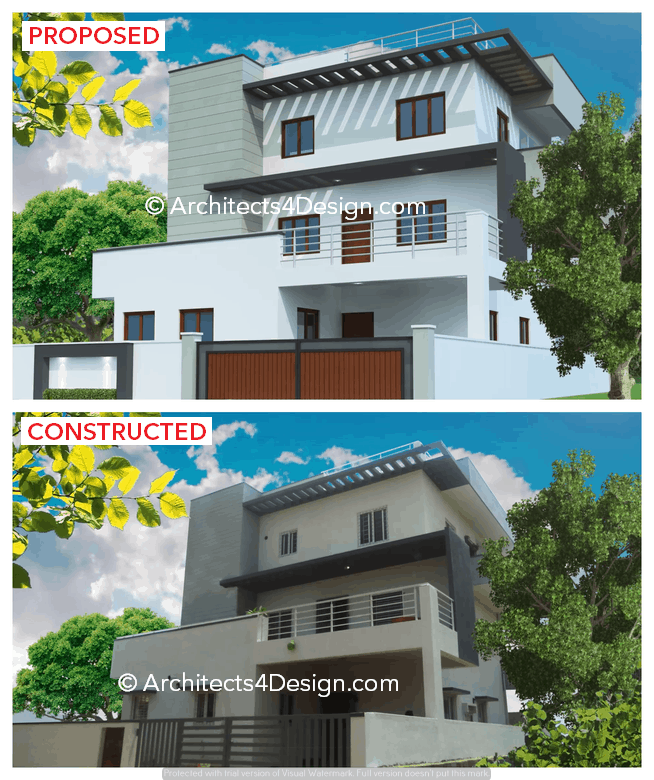

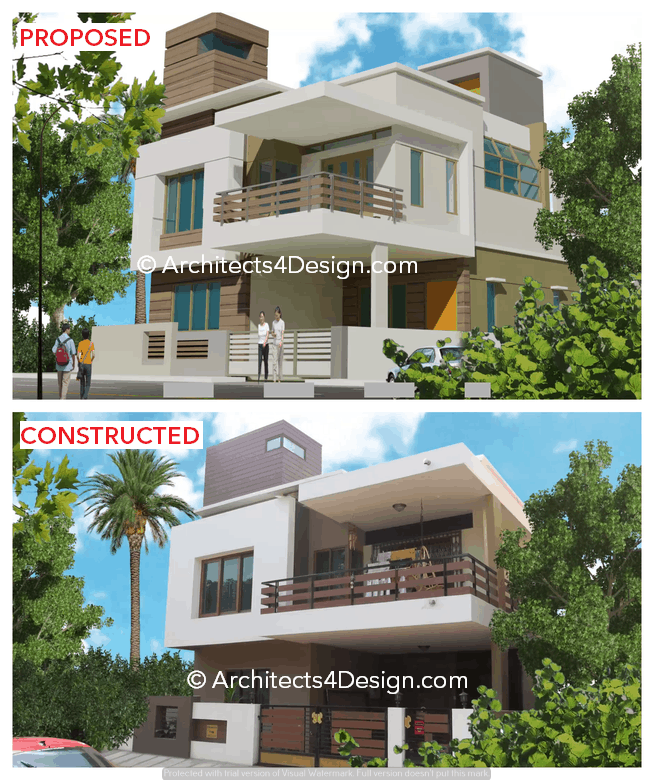
If you plan to build a house in Bangalore and wonder, What would be the Cost? Then used our advanced Construction cost in Bangalore calculator tool, which helps you calculate your House construction cost in Bangalore based on your requirements.
We offer our Services for Residential house plans, Apartment, Villa, Row house, Apartment planning, Structural Consultancy, Construction, and Master planning for group housing. Our way of working is to interact with the clients in understanding their needs and requirements, based on which we come up with the initial conceptual design.
These Architectural concepts show all the proposed house plans in Bangalore with 2D interior layouts. Based on these layouts, we make changes as per the Client's request; once the architectural floor plans are approved, we will get a 3D building elevation design to see How their home looks before the actual work starts.
For us Architecture is a VISUAL ART and the DESIGNS should Speak for its self . . . . !
Construction is a vast field; it's always tricky to understand How to start with House construction in Bangalore and its process. As Bangalore architects, we understand our clients' concerns by researching the current construction scenario by having detailed discussions with Building contractors, Labor Contractors, Plumbers, Fabrications, Electrical Consultants, Carpenters, Structural engineers, Painters, and many more construction-related consultants.
After having many such detailed discussions, we have given the below informative details in simple ways. Thus, every Client can understand the role of Architects, consultants, and the current market rates for the charge, which will help the Client know all the informative details required before meeting us.
As a top best Architects in Bangalore, we are further involved in Interior designing, for which we propose floor plans with the interior layout. These internal layout plans will be re-designed to optimize the space in Wardrobes' arrangement, Kitchen, Dining table, Cot, TV unit, Cabinets, Crockery unit, Washbasin TV area, Walk-in closet, Foyer, etc.
In the Case of Interior designing for residential homes/ Apartments, we first finalize the 2D floor plans. After this, we propose a 3D conceptual view designed based on the project's overall budget.
As residential architects in Bangalore, we take up a complete architectural consultancy for apartment projects. Our team involves concept floor plans, architectural working drawings, structural designing, and support to Building contractors to ensure that the work is proceeding on-site executed as per our given architectural drawings only.
As architects, we also do other services as we have a well Experienced team for Landscape designing, MEP consultancy, Structural Design, and Project management consultancy.
Contents
- 1 SELECTING the right PLOT or SITE for Building the HOUSE?
- 2 PLANNING the BUDGET Required for Construction?
- 3 HIRING RESIDENTIAL ARCHITECTS IN BANGALORE/Professionals for Designing?
- 4 FINALIZING House Plans or Floor Plans as per Requirements?
- 5 DESIGNING 2D or 3D Interior Layout for FINAL Floor Plans?
- 6 Designing 3D BUILDING ELEVATION as per final House Plans.?
- 7 A SOIL TEST to know the SOIL BEARING CAPACITY on the proposed site?
- 8 ARCHITECTURAL/STRUCTURAL Drawings are based on the final House Plans and Elevation?
- 9 Choosing BRICK or CONCRETE SOLID BLOCKS for Building Construction?
- 10 Choosing NATURAL SAND or M SAND (Manufactured Sand) in Construction?
- 11 Getting ACTUAL ESTIMATION done for House Construction by Bangalore Architects?
- 12 IDEAL Locations to Buy a Site in Bangalore as per your Budget?
- 13 Choosing the right BUILDING CONTRACTOR or LABOR CONTRACTOR?
- 14 PLAN SANCTION from BBMP/BDA/BMRDA for Starting construction?
- 15 Getting the TEMPORARY ELECTRICAL Connection from BESCOM?
- 16 BORE WELL Digging for WATER Supply?
- 17 CONSTRUCTING a TEMPORARY SHED for Watchman/Material Storage on Site?
- 18 SITE MARKING and DIGGING FOUNDATION as Per Structural Drawings?
- 19 SUMP TANK Construction for sufficient WATER Storage?
- 20 SUPERVISION by residential ARCHITECTS and STRUCTURAL Engineer during Construction?
- 21 Choosing the right CONSTRUCTION MATERIALS for Flooring/Bath Fittings/Electrical and more?
- 22 PERMISSION for ROAD CUTTING from BBMP for Laying Sewage Lines/Electrical?
- 23 Paying a FINAL BILL to the CONTRACTORS Approved by the Architects?
- 24 Procedure for APPLYING for New BWSSB WATER CONNECTION?
- 25 Fixing SOLAR WATER Heaters and RAINWATER Harvesting?
- 26 Overall summary of Architects checklists for Building a House in Bangalore
- 26.1 Residential Architects in Bangalore.
As ARCHITECTS IN BANGALORE, know the PROCEDURE OF BUILDING a HOUSE?
In Today's fast-moving era, everyone's first desire is to build their Dream Home. Bengaluru, a city of computers and IT technology, is where everyone has their first desire to have their home to live in.
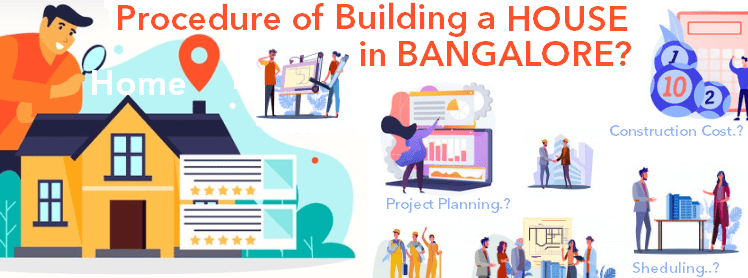 Today, building designs and constructions are the trends that are moving towards sustainable design and eco-friendly factors. So, once the new-to-be owners of a Home have their house designs ready, it's time for the project's construction management.
Today, building designs and constructions are the trends that are moving towards sustainable design and eco-friendly factors. So, once the new-to-be owners of a Home have their house designs ready, it's time for the project's construction management.
We feel that constructing a house is no Joke, we have taken sufficient Time and Research to compile the Step by Step process to make construction work simplified.
Before building a house in Bangalore, one must go through an entire process, right from site selection to project completion. Some of the steps an owner/client should go through while or before a house is constructed.
SELECTING the right PLOT or SITE for Building the HOUSE?
 There are several decisions that one has to consider while planning to build a house in Bangalore. One of the many obstacles that one faces while getting their home built with good Architects in Bangalore is one of the significant impediments.
There are several decisions that one has to consider while planning to build a house in Bangalore. One of the many obstacles that one faces while getting their home built with good Architects in Bangalore is one of the significant impediments.
LOCATION OF THE SITE:
The site area is one of the most considered factors because the surroundings affect the owners, be it directly or indirectly. Another thing that the buyer should note is that the soil condition is present in the location.
It would be advisable to consider Architects' suggestions or opinions to suggest the site dimension, facing, site orientation, etc., as per your requirements.
A site should be well located near Basic needs/necessities like Schools, Hospitals, Parks, Playgrounds, Supermarkets, Medical stores, and other daily essentials.
A good Architect can also guide you inthe selection of the Plot or Site. Below are the few factors that one should keep in mind while selecting/Buying a new plot/site for new home construction:
BUDGET:
There are different site dimensions possible like 20×30 or 600 sq ft, 30×40 or 1200 sq ft, 40×60 or 2400 sq ft, 50×80 or 4000 sq ft or larger sites. Such plots are approved by BDA, BMRDA, KIDB, BBMP, GRAM PANCHAYAT, and other revenue / b Khata sites, which are not DC converted or unapproved layouts. The Cost of a Site generally varies from site to site.
- Rs 35 lacs to Rs 45 lacs for a 20×30 site or 600 sq ft.
- Rs 45 lacs to 60 lacs for 30×40 site or 1200 sq ft.
- Rs 40 lacs to Rs 80 lacs for a 40×60 site or 2400 sq ft.
- Rs 70 lacs to Rs 1.3 cr for a 50×80 site or 4000 sq ft.
- Rs 35 lacs to Rs 65 lacs for Revenue sites.
One can read more about the 30×40 Construction cost and 40×60 Construction cost as the costing is explained in detail.
The Cost varies depending on the Prime location or how close it's located to the city center. Some of the prime locations trending today are HSR Layout, BTM Layout, Jayanagar, Indiranagar, JP Nagar, Koramangala, Sanjaynagar, Sarjapur road, Bannerghatta road, Hosur road, Kanakapura road, etc. The current going rates in these areas vary from Rs 2500 / sq ft to Rs 15,000 / sq ft.
EASY access to ESSENTIAL Services and EXISTING roads:
While buying a new plot for their home in Bangalore in a sparsely populated area, one needs to consider how and when the necessary things will be provided to their home.
The essential services are telephone lines and gas connections, but they also comprise sewage pipes, water supply, broadband internet, and even electricity.
NATURE OF SOIL:
The reactivity of soil is one of the significant factors that should be considered by the buyer while buying the plot. The ground should have good compression strength so that one can quickly Build a G+3 structure.
One can also find loose soil, which generally requires more steel and more reinforcement from a Structural Engineer. One has to ensure that the plot shouldn't have any loose soil or refill/dumped dirt.
PLANNING the BUDGET Required for Construction?
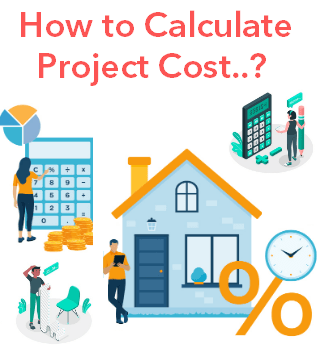 One has to Plan a budget required for building the Home/Project under the Architects guidance; This is the second most crucial factor that one needs to consider while budgeting a Project.
One has to Plan a budget required for building the Home/Project under the Architects guidance; This is the second most crucial factor that one needs to consider while budgeting a Project.
KEY Parameters to consider while planning the budget of a house..!
PHASES IN THE COST PLANNING PROCESS:
The procedure of planning the budget for the construction of the House in Bangalore comprises three stages majorly. First, it starts with establishing a realistic first estimate called the Preliminary Approximate Estimation Process.
The next crucial step is to estimate the construction cost and prepare detailed BOQ's which be required to get quotes from different contractors to execute the work.
Architects ensure that the exact design details for the various design elements can be built within the estimated cost plan, often called the Cost Checking phase.
The Client/Owner should adequately plan the budget required with the Help of Architects.
An accurate home construction budget helps in preparing all of the construction works and it's costing well in advance and An Architect can also plan the project time frames well in advance.
CASH FLOW PLAN:
Architects role in Budget planning is essential as he provides the basic stages required for the cash flow plan.
Along with the cash flow plan, budget planning must allocate the expenditure and income to each Client's financial year. Based on a stated inflation forecast, the assigned expenses should be given at a stated base data level and out turn levels.
ADDITIONAL FEATURES BY ANALYZING THE BUDGET PLAN:
With the help of budget planning, the Client gets a basis to evaluate different projects' assortment.
Also, one can get an advantage of a balanced distribution of expenditure among various project parts.
The budget planning specifies the proposed estimate given by Architects and improves the quality and performance, but there is quite less possibility of codicil invoice of necessary quantities.
Hence, the budget planning will help the owner or Client get ensured. Once a realistic estimate is agreed upon between the parties, everything that follows up starts from the successful contractor tender to the final project cost.
HIRING RESIDENTIAL ARCHITECTS IN BANGALORE/Professionals for Designing?
Many Clients Decide/Think to design their homes independently, which negatively affects them in the Long run. It is quite challenging for some to decide between Hiring Architects or Getting the Design work by themselves.
While the ones who think that hiring Architects are not essential should consider factors like local bylaws, building codes, green design issues, and ensuring your dreams are realistic within the budget.
ADVANTAGES of HIRING an ARCHITECT or Professionals for a Project..!
PROFESSIONAL ARCHITECT PLANNING CAN SAVE TIME AND MONEY:
Most clients who don't Hire Architects in Bengaluru decide to design their homes independently and might not know various things. Some of them include How the Structural choices impact installing the mechanical system, substitutes for various construction materials, and comparatively cheaper technologies.
A skilled professional like an Architects/Structural Engineers/Experienced Team will have the best knowledge of building science would get the building projects through which the minimum number of revisions and each revision requires a lot of time.
Hence, hiring Architects will help in Saving Time and get the plan sanction plan on time.
Hence, one should take the services of professional architectural firms in Bangalore to Save Time and Money. Also, one can avoid many sleepless nights on their project by making wrong options/advice.
PROFESSIONAL GUIDANCE:
Suppose the Client or owner of the home is having particular problems with the Building contractors on their project. In that case, it will turn into monotonous work to verify that they correctly carry out the drawings' content.
Architects play a crucial role in managing and appointing various other sub-contractors in the process, ensuring that the project completes on time without compromising the construction quality.
One might face some problems concerning Quality of construction, not utilizing the right construction materials of approved make, not following drawings given by the Architect/Engineers.
Hence, one of the significant factors in hiring a Professional Team with a broad knowledge in the construction field. It is hard to know where the responsibility of an Architect or a Contractor ends and begins.
EASY ACCESS TO OTHER SKILLED PROS:
Hiring professionals welcome bundles of pros to the project from choosing the right Skilled Structural engineers, Painters, Plumbers, Electricians, Skilled workers, Floor layers, Building contractors, Labor contractors, etc.
An experienced Team of Architects will have the right network of skilled contractors in all civil works to help the owner get their job done within their planned budget.
Hence, the most critical benefit is time-saving is worth every penny. As said that "Architects can't force people to connect." It can only plan the crossing points, remove barriers, and make the meeting places useful and attractive."
FINALIZING House Plans or Floor Plans as per Requirements?
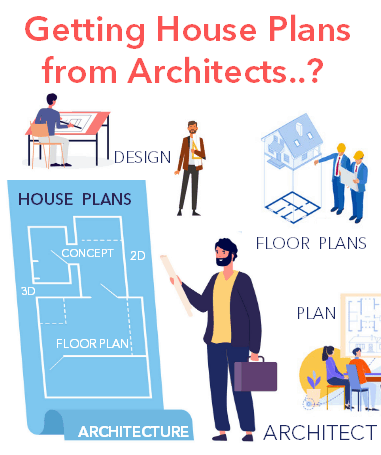 It's important to finalize the home plans or Floor Plans given by Architects, which will be as per the owner or Client's requirement.
It's important to finalize the home plans or Floor Plans given by Architects, which will be as per the owner or Client's requirement.
To see some of our works, visit the links to Duplex house plans, where a few samples of duplex houses are shared.
Architectural floor plans or house plans proposed by Bangalore Architects as per the owner's need majorly comprises various procedures, starting right from working on the project's pros and cons.
One can visit the link 30×40 house plans and 40×60 house plans, where a few sample house designs are shared.
FEW things that One needs to know about FINALIZING Floor/House plans..!
REQUIREMENTS TO BE REFLECTED ON THE FLOOR PLAN:
After reviewing all the planning factors fulfilled based on the given conditions, the Client finally approves to prepare detailed site working drawings presented by the Architects.
The significant factors that should be reflected in the home plans or floor plans are the measurements with Room sizes' dimensions, Positions of Ares. Some areas are living rooms, bedrooms, Dining rooms, Bathrooms, Puja room, Kitchen, Utility, Entrance, Car parking, and other elements.
Architects prepare all the needed schematic floor plans, 2D&3D elevation plans, Interior layouts and making the required changes until the client/owner approves the concept.
PLANNING AS PER BYLAWS:
Architects will consider the width of the road, site location, soil condition, current bylaws for plan sanction, FAR possibilities from BDA BBMP BMRDA GRAM Panchayats, etc., and propose the initial plans. The plans shouldn't comprise land-use zoning and the provision of adequate circulation and parking areas.
Read about the complete details on Plans sanction/approval in Bangalore from BDA/BMRDA/BBMP, and the entire process of plan approval is well explained.
Lastly, the site plan/floor plan should reflect the requirements set by the authority like BBMP BDA BMRDA. In addition, the owner should understand the FAR possibilities and the possible penalties for building violations.
ORIENTATION OF HOUSE:
The finalizing procedure of the final floor plan given or proposed by the Architects should consist of the home's direction. The orientation of the House should be in the context of climatic factors.
The climatic factors should comprise maximum airflow through the House's windows and minimize the solar heat gain by staggering the houses about each other and orienting them on the east-west axis.
DISCUSSION ON FLOOR PLANS:
The essential part of finalizing the final floor plan is consulting or discussing with family members and considering the planning. Architects based in Bangalore also examine the layout of the project and the house designs for the proposed home to see if they fulfill all the requirements set down by the Client.
The Client will be presented with some alternative floor layouts so that the most suitable Architectural Floor plan can be chosen or finalized.
Hence, finalizing the final floor plan plays a vital role in making allowance for existing facilities and designing the Structural drawings, Architectural working drawings, etc.
DESIGNING 2D or 3D Interior Layout for FINAL Floor Plans?
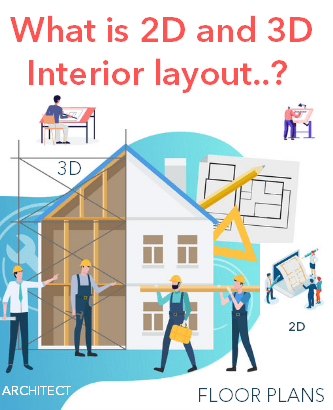 While designing residential homes with the help of residential architects in Bangalore and other designing professionals, one of the most challenging tasks is to create drawings that can convey the proposed interior design ideas in a 2D and 3D layout drawing presentation.
While designing residential homes with the help of residential architects in Bangalore and other designing professionals, one of the most challenging tasks is to create drawings that can convey the proposed interior design ideas in a 2D and 3D layout drawing presentation.
IMPORTANCE for Getting a 2D and 3D View..!
In this competitive market, the Architects need to make sure that all the strategic decisions taken at every step of designing would keep the Client's costs down and deliver quality design work that would stand down out uniquely in the crowd.
Getting 2D INTERIOR Layout:
Making a 2D design is nothing but a 2-Dimensional view showing all the measurements, room names, and sizes, followed by creating high-resolution output and personalizing the colors and branding. Hence, the 2D structure is ready.
While creating a 3D interior layout design, one can follow the three necessary steps.
An Architectural 2D and 3D drawings help the client understand the positions of furniture and fixtures like the sofa, center table, coffee table, cots, wardrobes, dressing table, side tables, chairs, dining table, kitchen layouts, computer table, etc.
Getting 3D INTERIOR Layout:
After finalizing the final floor plan with the basic 2d interior layout given by the skilled professionals, they are followed by proposing Design concepts for the flooring, walls, and ceiling materials. Finally, after the decorative part is done, furnish the design accordingly.
Lastly, Architects need to create a 3D realistic photo and view the model in live 3D, and hence visualizing the 3D structure becomes easier.
Designing 3D BUILDING ELEVATION as per final House Plans.?
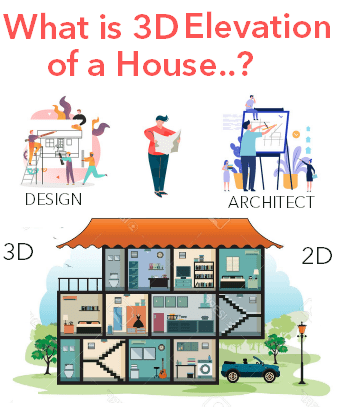 Architects advantage of getting 3D Elevation design shows the building facade's actual realistic view (front view), including the color combinations, compound, balcony, cladding material, doors, windows, gates, railing concepts, cladding design, etc.
Architects advantage of getting 3D Elevation design shows the building facade's actual realistic view (front view), including the color combinations, compound, balcony, cladding material, doors, windows, gates, railing concepts, cladding design, etc.
Architects charge for creating a 3D view concept from the final home designs will cost anywhere upwards of Rs 20,000 for a realistic render. There are different kinds of 3D opinions like Day view, Night view, Aerial view, Worms eys view, Street view, etc.
Different 3D VIEWS and the Advantages of getting 3D Building Elevation done..!
Realistic 3D Elevation in DAY view:
The 3D Elevation of a residential building proposed by the Architects provides the practical concept for visualizing one's dream house even before it is constructed, saving time, money, altering, variating, and enhancing unwanted areas of their aesthetics.
A 3D day view of the Building concept helps a client visually imagine his home, which shows all the simple aspects.
Some of the details shown are the concept, colors, textures, cladding, compound, gates, French windows, construction material details. Many other things help the Client get the required changes in the initial design phase rather than getting it done while the building is under construction.
The 3D elevation concept view can be done for Residential Bungalows, Rental homes, Villas, Row house, Masterplan, etc.
Realistic 3D Elevation in NIGHT view:
A Night view proposed by Architects generally helps the Client to visualize the 3D aspects of the interiors as well as the exteriors along with the actual proposed light fixtures in the interior walls as well as on the surfaces such as the compound, gates, landscaping, front facade, Building night view, etc.
It also helps the Architects show the Client sufficient illumination; if not, one can rework the concept again.
Usually, at night, the home's picturesque view looks even more breathtakingly amazing when designed with suitable external lighting arrangements with the opposite light point's implementation. One can see the position of all electrical light fittings on the building and landscape.
What is WORMS EYE View:
A Worm's eye view that generally a 3D concept generated concerning a worm's perspective of the building or object. This view shows the bottom to the top visual idea, which a longer or front view cannot capture.
A worm's eye view is a suitable option for narrow concepts such as Villas, Masterplan, Apartment complexes, Rowhouses, Malls, Column views, Facade views, etc.
What is AERIAL VIEW:
Also, the Aerial Eye View proves to be quite beneficial while viewing the elevation of the 3D design. Envisaging the 3D aerial view from a high altitude or Top view of the entire Master plan would help the Client see vast area surroundings, including the proposed landscaping concept around the project, which can be either a township or an individual bungalow.
This view reveals a comprehensive and detailed picture of the architectural proposed design's exterior parts such as play areas, clubhouse, park, parking lots, swimming pool, jogging track, pathway, etc.
Hence, getting an Elevation of a building in 3D views is beneficial. Each small design can be seen and rectified if needed before the construction, which helps the contractor work on the site and implements the project in Reality as per the Final Building 3D view.
A SOIL TEST to know the SOIL BEARING CAPACITY on the proposed site?
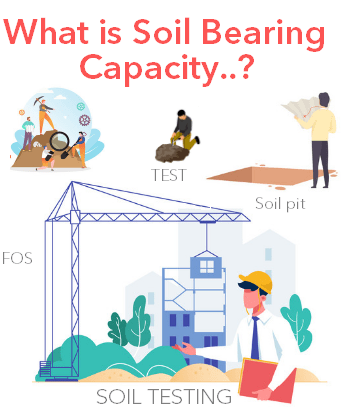 It's the soil's bearing capacity, which bears the structure's entire Structural load. It's calculated as the maximum contact average pressure between the ground and the foundation.
It's the soil's bearing capacity, which bears the structure's entire Structural load. It's calculated as the maximum contact average pressure between the ground and the foundation.
PROCEDURE TO MEASURE THE SOIL BEARING CAPACITY :
One needs to Excavate/Dig the required depth at the proposed site confirmed by the Architects. Next, the soil bearing capacity test needs to be done, after which a solid square or solid ball of pre-recorded weight and dimensions should be noted and then dropped multiple times from a prefixed height to the pit bottom surface.
Then, one needs to get down into the pit to measure the solid object's average depth and record the impression's mean depth. Also, one needs to keep the selected Architects in Bangalore in the loop about the site's soil bearing capacity report.
HOW to CALCULATE Soil Bearing Capacity..!
R = (W * H) / D
Where,
R = The ultimate resistance of the soil, which can is-weighed in kilograms.
D = The average depth of the impression, which is considered in centimeters.
W = The weight of the solid ball or the square-cube, which is considered kilograms.
H = The height of the fall of the solid ball or the cube, which isconsideredin centimeters.
The resistance of soil per unit area = R/A
Safe bearing capacity = R / (A * F.O.S)
Where,
A = the cross-sectional area of the solid ball or the square cube.
F.O.S. = Factor of Safety.
The below table shows the soil bearing capacities with values for different types of soil conditions on site. Based on the values found by the soil testing report the structural engineer will design the structure accordingly.
| Architects in Bangalore about Type of Soil / Rock | Safe / Allowable Bearing Capacity (kg/cm 2 ) |
| Rock | 32.40 |
| Soft rock | 4.40 |
| Coarse sand | 4.40 |
| Medium sand | 2.45 |
| Fine sand | 4.40 |
| Softshell / Stiff clay | 1.00 |
| Soft clay | 1.00 |
| Very soft clay | 0.50 |
What is meant by FACTOR OF SAFETY:
The safety factor should be that it varies from 2 to 3 depending upon the type of structure and the site's condition. Also, to get the most reliable test results, one should perform this test on antithetic kinds of soils and use their judgments before reaching any conclusion.
Lastly, one should always remember that instead of using the solid steel ball or the square cube, one can also use the CBR test plunger or the Cone.
ARCHITECTURAL/STRUCTURAL Drawings are based on the final House Plans and Elevation?
 The primary advantage of having detailed working drawings given by the Architects and Structural engineers, which help the project be built as per concept in the process, the contractor also avoids mistakes, reducing the redo works.
The primary advantage of having detailed working drawings given by the Architects and Structural engineers, which help the project be built as per concept in the process, the contractor also avoids mistakes, reducing the redo works.
Various forms of architectural or structural drawings areas are listed below..!
WORKING DRAWINGS PREPARED AS PER SCALE:
All these details given by the Architects are required at the construction site, which needs to be followed by all civil contractors and subcontractors like Plumbers, Electricians, Flooring layers, Fabricators, labor contractors, Centering workers, etc.
Generally, all practical details are designed on the Antithetic Scale at 1/4 per foot, and a 1″ line drawn is equal to 4′(feet). Similarly, a 4″(inches) line equals 16′(feet) based on this scale. The selected architects prepare all detailed architectural drawings.
ARCHITECTURAL WORKING DRAWINGS:
The drawings prepared by professional Architects for a residential or commercial project?
These drawings contain detailed design symbols that will make it easier/familiar with all the different contractors to understand the given dimensions like height, width, span, position, projections, niches, etc.
Ensure that the contractors work under the Architects' guidance, providing and supporting all required architectural working drawings.
After freezing the residential house plans and building elevation design, one needs to have all the required drawings from the appointed Architects. The concept drawings given by the hired Bangalore architects show the Rooms, Windows, Doors, Entrance, Concept view, etc.
But to execute the same on the site, one needs to have working details. For example, in a window, one needs to know its height, width, grill design, material, thickness, shutter, etc. These working architecture details help one execute the project precisely.
Some of the Architectural working drawings given by top Architects in Bangalore at the confirmation of House plans are Civil work details, Electrical, Plumbing, Staircase, Cladding, Flooring pattern, Wall detailing, 2D working interior layout, Windows, Doors, Main door, landscaping, Entrance, Parking, etc.
STRUCTURAL WORKING DRAWINGS:
Once the concepts given by the Architects are approved, the next step is to prepare structural drawings that are prepared by a qualified Structural engineer who plans out the column and beams layout design for the proposed, approved final plan.
These drawings include foundation drawings, Footing, Beams, Plinth beam, Slab reinforcement, Slab projection details, Staircase steel reinforcement, and many other related structural drawings.
A structural engineer has to work with the Architect so that the structural drawings are at sink with all the related architectural details. So, the project executes as per the proposed Plan and elevation design.
Hence, a complete set of home designs mainly comprises floor plans, sections, elevations, and details, which, when pictured together in one frame from the detailed picture of the entire home.
Choosing BRICK or CONCRETE SOLID BLOCKS for Building Construction?
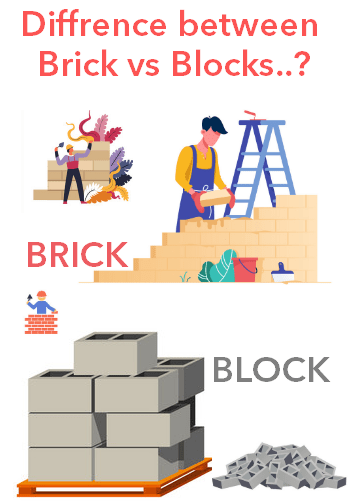
WHAT IS BRICK:
Bricks are rectangular blocks made from clay, shale, slate, concrete, calcium silicate, or stone.
Bricks are made by first blending the sand and water, followed by pressing the earth into steel molds and heating the mixture at a high temperature of about 1000 degrees Celsius, maintaining the brick's strength.
There are other options like Wire cut bricks, Compressed earth blocks, Laterite stones, etc. These can be implemented in eco-friendly building design.
However, it's advised to suggest Architects of the materials that need to be used for the project.
WHAT IS CONCRETE SOLID BLOCK:
A block is made from concrete—blocks used as partitions in interior applications, walls, compounds, temporary structures, and exterior applications.
It can also be used as a structural component of the home.
DIFFERENCE between BRICKS and CEMENT-based SOLID Blocks..!
Although both the bricks and the blocks are durable and fire-resistant, insect-proof building materials also have dissimilarities. Therefore, when one decides to build a new house in Bangalore, it's highly recommended to know its pros and cons.
By INSULATION VALUE:
The insulation valve or the primary Brick walls' R-value is about 0.2 per square inch, while the Solid concrete blocks are about 2.5 per square inch. Therefore, many homes in Bangalore built from the Bricks have better insulation values than the other Solid Block-built buildings.
By STRENGTH:
Both the bricks and the blocks are strong enough to be used, but their real strength is majorly affected by the type and the quality of the mortar that holds them together.
According to one survey, all the blocks should have a minimum compression strength of at least1900 pounds per square inch if intended for home construction, yet many denser blocks are much more durable than this. Also, the researchers have proved that the average concrete block can withstand 3500 pounds per square inch.
By COST:
The bricks and the Solid blocks are both almost equally expensive. According to the current Cost of 2016, one single clay brick or wire cut bricks. Bricks cost Rs 6 to Rs 9 per piece, while an 8-inch Solid concrete block costs Rs 30 to Rs 45 per block.
Most of the time, the labor charges bring up the wall prices more significant when compared to the actual material cost. As house architects, one needs to keep in mind that traditional brick masonry requires more skill when compared to concrete masonry, and hence is quite challenging to be done on their own.
Choosing NATURAL SAND or M SAND (Manufactured Sand) in Construction?
 Natural sand, also called the natural river sand, was considered the cheapest resource of sand.
Natural sand, also called the natural river sand, was considered the cheapest resource of sand.
But the excessive mining of the river bed in meeting the increasing demand for the sand in the construction industry may lead to an ecological imbalance in the country.
While the sand is available today, the river bed is coarse and contains very high silt and clay percentages.
Due to an increasingly urban population that has created a high demand for housing in an Urban city like Bangalore, there is a vast difference between the demand and supply of natural sand, leading to contamination with clay and silt.
DIFFERENCES between the NATURAL Sand and the M-Sand..!
S HAPE AND COLOR:
Natural river sand is light brownish compared to M Sand ( manufactured sand), grey in color. But both the sands do differ from each other concerning the shape of the particle.
The shape of the Manufactured sand is cubical, while the natural river sand has a flaky form.
MANUFACTURING PROCESS:
Any material's manufacturing process depends on its stability, reliability, Cost, shape, size, and many other factors. The same is true for the antithetic forms of sane.
The manufactured sand is prepared with international technology controlled by the manufacturing process through the imported machines, while the natural river sand is natural.
The natural river sand has no controlled manufacturing process because the by-product of the stone crusher obtains it.
SUITABILITY FOR CONCRETING:
The building contractors bring the construction materials, which are to be used to build the House. The Client / Owner and the builder must know about the right sand to better suit the concrete.
The manufactured sand is recommended forconcrete works and civil masonry works worldwide by many renowned concrete technologists.
While the natural river sand is not as recommended as the manufactured sand for use in concrete and masonry works. The river sand doesn't seem proper to the perfect quality to be used in concrete.
Getting ACTUAL ESTIMATION done for House Construction by Bangalore Architects?
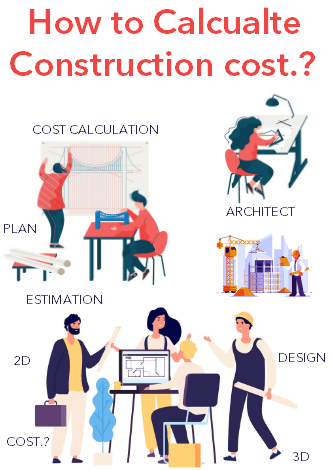 The House construction Estimation determines the probable construction cost of the project.
The House construction Estimation determines the probable construction cost of the project.
Usually, the Building estimation can be done at any stage of the project, depending upon the evaluation's purpose. However, as Architects, we do the first estimation before starting the construction to make the project's budget plan.
The residential home estimation is calculated in quantities like earthwork, blocks, brickwork in the plinth, flooring, painting, superstructure, plastering, bricks, foundation concrete, fittings, and many other things are comprised in the estimation process of the home.
Generally, one uses abbreviations for quantities measured:
Sq ft or Sft (square feet) , Cft (cubic feet) , RFT (running feet) , L.S (lump sum) , Lts (litters) Kilograms (Kg) etc
HOUSE ESTIMATION can be Done by below Methods..!
LONGWALL – SHORT WALL METHOD:
In this method, the longwall, which is a wall that is along the room's length, whereas the Short wall is the wall that is perpendicular to the long wall. Therefore, to determine short and longwall lengths, one should first know the centerline of the single wall.
After which, the length of the longwall might be calculated, and there the addition of the half breadth at each end to its centerline length. Thus the lengths of the short wall which is measured. This can also be calculated by deducting the half breadth from its centerline length at each end.
The longwall length usually decreases from earthwork to brickwork in the superstructure, while that of the short wall increases. These lengths are then multiplied by breadth and depth to get the quantities.
CENTERLINE METHOD:
The center-line method is most suitable for the walls that have similar cross-section areas. In this method, the total center-line length ismultiplied by the respective item's breadth and depth, and hence one gets the whole time.
When cross walls, partitions, or veranda walls attach to the main wall, the centerline length is reduced by half of the junction's breadth. Therefore, such a junction or joints are studied carefully while calculating the total center-line length. As a result, the estimates that are being prepared by this method are most accurate and quick.
Hence, the estimation should be done in various stages of the project by the residential Architects / Engineers to get the project's perfect budget plan. The Current House Construction cost in Bangalore is Rs 1600 / sq ft, excluding Architectural design fees.
IDEAL Locations to Buy a Site in Bangalore as per your Budget?
 As Architects, we feel Constructing a dream home within the given or a fixed Budget is more or less a challenge to complete.
As Architects, we feel Constructing a dream home within the given or a fixed Budget is more or less a challenge to complete.
At least one can allow 50 to 60% of their available Budget for buying a Site that is close by to good Schools, Stores, Malls, Metro station, Traffic movement, and also closed to the workplace of the owner as it will reduce the travel time from home to office and back.
How to Shortlist:
– Plan your budget.
– Consult an Architect.
– Preplan your cost estimation.
– Nearby amenities.
– Discuss the overall Cost (Design+Build)
We have listed below the ideal localities to Build your Home.
If you are looking for Architects in Bangalore to get your Residential house plans or Turnkey, one can consider the below locations to purchase your site/plot.
| AREA | IDEAL LOCATIONS TO BUY A SITE. As Architects in Bangalore/Residential Architects in Bangalore, below are ideal loc to buy a Plot. |
|---|---|
| BANGALORE SOUTH | Sarjapur Road HSR Layout Subramanyapura Kempe Gowda Road Vivek Nagar BTM Layout Magrath Road Konanakunte Gavipuram JP Nagar Madivala Padmanabhanagar Dickenson Road Uttarahalli Wilson Garden Bommanahalli VV Puram Ulsoor Hosur Road Kammanahalli Mission Road Koramangala Langford Town Bannerghatta Road Kathriguppe Dasarahalli Hanumanthanagar St. Mark's Road Chamarajpet Kasturba Road Kumaraswamy Layout Banashankari Begur Doddamavalli ShantiNagar Electronics City Raj Bhavan Road Sankey Road MG Road Sampangiram Nagar Jayanagar Nagarathpet Peenya Rajarajeshwari Ashok Nagar Doddakallasandra Museum Road Residency Road. |
| BANGALORE EAST | Bellandur KR Puram Ramamurthy Nagar Krishnaraja Puram Vimanapura Thippasandra Whitefield HRBR Layout HAL Road Brookefield Marathahalli Brigade Road Dooravani Nagar Old Airport Road CV Raman Nagar Jeevan Bheema Mahadevapura Kadugodi Domlur Jayamahal Road Varthur ITPL Byatarayanapura Kodihalli Indiranagar. |
| BANGALORE WEST | Kengeri Vidyaranyapura Tumkur Road Vijay Nagar Mysore Road Nagarbhavi Gandhi Nagar Basaveshwaranagar Bidadi Mahalakshmipuram. |
| BANGALORE CENTRAL | Benson Town Church Street Lady Curzon Road Avenue Road Basavanagudi Richmond Road Rajaji Nagar Chatram Road Vittal Mallya Road Seshadri Road Magadi Road Infantry Road Commercial Street Shivajinagar Austin Town Crescent Road Lavelle road Cunningham road Chickpet Kumara Krupa Road Chickpet Road Cox Town Srirampuram Vasanth Nagar Balepet RT Nagar Adugodi Palace Road High Grounds Subedar Richmond Town. |
Choosing the right BUILDING CONTRACTOR or LABOR CONTRACTOR?
 There is a significant difference between building Contractors and labor contractors. Therefore, one needs to know while hiring a contractor for the construction of their home.
There is a significant difference between building Contractors and labor contractors. Therefore, one needs to know while hiring a contractor for the construction of their home.
One should keep in mind the points that are the primary differences between them.
MAJOR Difference Between them..!
Who is a BUILDING CONTRACTOR..?
A building contractor is a person who provides the agreed services, which include the construction materials and labor, to a client for a set fee.
The will be a signed contract agreement that mentions the possible duration – under a contract for the services, which is in contrast to a deal of service, for example, a contract of employment, mainly between an employee and an employer.
In this, the responsibility will be including Construction materials + Labor. The Client will be having one point of contact for getting things done.
This Option is more advisablesince the Building contractor takes the entire responsibility of Purchasing the construction materials + Implementation as per the Architect's guidance.
Who is a Labor Contractor?
The labor contractors are the team of workers who undertake a contract from the building contractor. A labor contractor can be anything from an individual self-employed person – for example; a plumber is carrying out work for a building contractor – to a large national organization.
In this case, one needs to provide the materials to the project, and he executes the plan.
This option is not advisable if the Client is a working professional and cannot involve or give time in purchasing the material, managing the site, or having difficulties coordinating works. The labor contractor's responsibilities are to Implement procured construction material.
PLAN SANCTION from BBMP/BDA/BMRDA for Starting construction?
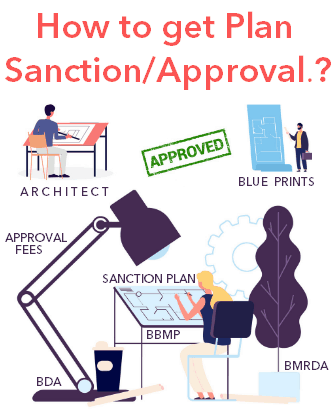 One needs to keep in mind that even before starting the construction of a building, one should know the various agencies involved in the layout and the building plan approval.
One needs to keep in mind that even before starting the construction of a building, one should know the various agencies involved in the layout and the building plan approval.
Some of the central agencies involved in real estate include BBMP, BDA, BMRDA, GRAM PANCHAYAT, KIDB, BIAAPA, DTCP, LDA, etc.
PROCEDURE to get BUILDING PLAN APPROVAL from BBMP and BDA..!
BBMP PLAN SANCTION:
If the homeowner wishes to Construct a house in Bangalore, they should get approval from the concerned authorities.
BBMP, the abbreviation used for Bruhat Bangalore Mahanagara Palike, approves the procedure within its jurisdiction to issue approval letters to builders or site owners to construct a new house.
As per bylaws, the FAR depends on the road's width and the zonal regulations like residential or commercial.
Any violations in the actual construction, the authority has strict rules to demolish the site's deviation.
BDA PLAN SANCTION:
The BDA, the Bangalore Development Authority's abbreviation, is the Bangalore principal planning authority. As a regulatory body, the BDA will prepare a comprehensive development plan. In addition to the planning and development, the agency will also supervise the construction of related services and sites.
It also ensures that the requirement of all of the underprivileged citizens will also meet without any failure. The body was created in the year 1976 under the Bangalore Development Authority Act 1976. The layouts in lands and approvals will be approved through the BDA.
The layouts usually fall outside the city limits will be looked after by the Bangalore Metropolitan Region Development Authority (BMRDA).
The BDA plan sanctions the fees or charges vary depending on the project's scales, whether in schools, Villas, Rowhouses, Apartment complexes, Large developments, Commercial development, etc. As a result, it is much easier to get the approvals done through the right intermediaries, mediators, or agents who make it hassle-free.
Getting the TEMPORARY ELECTRICAL Connection from BESCOM?
 BESCOM, the abbreviation used for the Bangalore Electricity Supply Company, distributes power to Bangalore's districts.
BESCOM, the abbreviation used for the Bangalore Electricity Supply Company, distributes power to Bangalore's districts.
So, if one plans to move into a new house, he has to take minimum temporary power to start building construction; in any case, one needs to apply for an electricity connection with BESCOM.
One can read on How to apply for a BESCOM connection in Bangalore and the charges.
The page explains in detail the process of getting approval, Documentation required, BESCOM meter Deposits, Getting Temporary connection, etc.
The below-mentioned list provides the steps to follow to get a domestic LT connection applicable for less than 25 KW or less than 500 square meters of built-up area.
The procedure of getting BESCOM CONNECTION..!
Visit Office: One needs to visit the BESCOM, the sub-divisional office in their particular locality, and obtain an A Form application form.
Fill & Submit FORM:
Then fill this application with all the required details and register or submit the form along with specified documents as proof of ownership or currentpremises, home tax receipt, personal ID proof, Passport size photo, and Mobile Number Power Supply Agreement.
PSA Agreement:
The Power Supply Agreement format is available at the BESCOM office, or one can visit their official site to download it, along with the registration fee that one needs to pay for the same, which is Rs. 50 per installation.
Registration:
The owner will then be provided with a registration number that they can use to track or know their connection's current status and duly verify the documents that one has submitted.
Officer Inspection:
After this, a field officer representing Bangalore Electricity Supply Company will inspect their home or site where the owner wishes a connection.
Once the authorized field officer from BESCOM verifies the documents, he will prepare a detailed estimate for the work that needs to be carried out.
The next step is to submit the proposed wiring diagram of the commercial/residential building and test report cum completion by Government licensed electrical contractors showing and confirming the wiring and duly signing it.
Pay Deposits:
Once the proposed power requirement is approved, the owner needs topay a couple of deposits and infrastructure charges.
Timeline:
The Sanction is valid for one month, so the owner must ensure that they make the deposits' payment within one month of obtaining the sanction.
Report:
The total amount needs to be paid at the sub-divisional BESCOM office; after that, the owner can submit the completion report and the wiring diagram and Power Supply Agreement.
RR Number:
Lastly, the sub-divisional office will then issue a final work order. Then, an authorized Area Engineer will install the meter, obtain a revenue record (RR number), and finally provide the service connection.
BORE WELL Digging for WATER Supply?
 Today, nobody prefers an open well iin the New generation nstead of a bore well dug to get the water supply.
Today, nobody prefers an open well iin the New generation nstead of a bore well dug to get the water supply.
This is because of the simple reason that an open well requires a large area, and the quality of water is not as good as that of a Borewell.
To know the precise location for digging, the Architects and the structural engineer should coordinate as per the hired architects' final residential house plans where a suitable point can be marked for drilling.
SITE SELECTION OF BOREWELL:
Before digging, one should research the surrounding area water table and the depth of bore nearby wells.
Also, one can engage a water diviner to survey a suitable point of digging. Water Diviners can be easily found nearby to suggest different locations possible to get the best water source.
SUITABLE TIME OF DIGGING:
Though it is proper to dig in every season, one is usually advised to drill the well in the summer season.
This is done because, at that time, the water levels lower down to their minimum standard, which will let you know the availability of water from the excellent source even when the water table is at its bottom during summer.
TO GET PERMISSION FROM GOVERNMENT AUTHORITIES:
Before digging a borewell, permission is required from the local Municipal or Water Supply or other Government authorities in many states. If such is the case, then getting approval before finalizing a contractor for digging is vital.
CONSTRUCTING a TEMPORARY SHED for Watchman/Material Storage on Site?
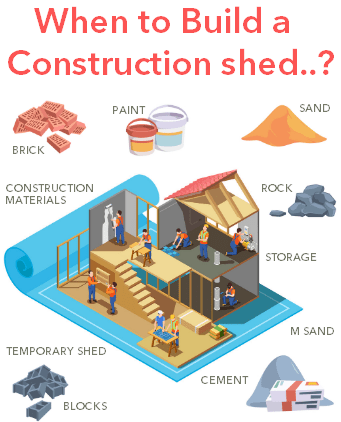
Before the actual construction starts and just after digging the bore well, the Next step is to Build Temporary structures for Storing construction materials and space for a guard to stay to look after or secure the building materials.
A shed is imperative for storing many types of building or construction material such as Cement bags, Construction steel, Jelly aggregates, Sand, Bath-ware fittings, Flooring, Plumbing materials, etc., keeping under a secured roof.
A Watchman or a caretaker will stay on the site 24×7 on-site and take care of the construction materials.
It will also give a sense of security to the site and prevents unwanted thefts.
BEST LOCATION to Build a Temporary Shed..!
ADJACENT EMPTY SITE:
The ideal place for setting up a temporary shed is always in an empty adjacent site. To achieve this, one should get permission from the neighboring Site owners in advance.
If permission is denied or there is no empty adjacent site, one has to consider other alternatives.
CORNER OF A BIG SITE:
If the site is big, erecting a Temporary shed at the plot's corner location can also be considered. So it doesn't disturb any construction activity like foundation, plinth work, etc.
AVAILABLE SPACE IN A SMALL SITE:
If the site is small, one needs to build the shed in whatever space is available in the setback area. Then, once the ground floor slab is cast, one can shift the storage stuff into a building room.
Materials Used for Constructing a Shed:
Since the shed is a temporary structure, one can consider using soil instead of using cement as mortar to fill up the masonry works in bricks/ Solid concrete blocks. Then, once the entire building is completed,one can easily removethese structures and use the Bricks or Blocks to build compounds or final interior walls.
SITE MARKING and DIGGING FOUNDATION as Per Structural Drawings?
 When one has cleared the site and is ready to start setting out the build, they now have to position their House in the exact position proposed in their plans.
When one has cleared the site and is ready to start setting out the build, they now have to position their House in the exact position proposed in their plans.
Advise of good Architects and Structural Engineers should be coordinated to finalize the markings for foundations and plinth.
One has to make sure that Regular checks are done by an Engineer frequently, especially during the foundation stage, which is a critical part of executing any project.
There is a good chance that the licensed commercial or residential Architects approve the selected/approved building contractor at Bangalore, who doesn't make any mistakes at this critical construction phase.
FOUNDATION OF A BUILDING:
Foundation is a part of the building's structure designed to take the proposed building structure's entire load. It also can be defined as the part of the residential building that is below the plinth level.
Generally, it's planned to distribute the entire load using the Plinth beam, Columns, Slabs, Beams, Walls, etc.
As per the structural drawings stage, the site marking and digging foundation is to establish the dig. The Architects and Structural engineers need to visit the house construction site to coordinate with the building contractors to mark the required foundation pit for the columns and plinth beam.
DRAWINGS are given at this STAGE:
Foundation details, Pit dig layout, Concrete design, Column sizes, Plinth sizes, Height of the plinth, parking heights, etc.
DIFFERENT CIVIL WORKS INVOLVED IN FOUNDATION:
Foundation involves many critical civil works that have to be executed precisely; any mistakes done here can't be rectified. Some of the works include Site marking, Pit excavation, 40 mm Concrete, Steel reinforcement for columns and beams, Concrete pouring, Curing, Plinth frame-work, Plinth beam casting, etc.
There might be other works to carry out depending on the house plans proposed.
Once the concrete has poured as per design, one needs to fill the entire soil and compact it up to the plinth top height. After this, Anti termite treatment in powder or liquid must be treated to the soil to avoid any Termite colonies settling later on, which might create voids.
SUMP TANK Construction for sufficient WATER Storage?
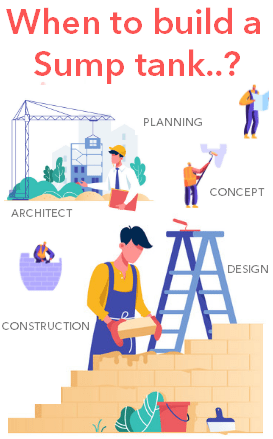 CONSTRUCTION OF SUMP:
CONSTRUCTION OF SUMP:
A sump tank should be constructed on priority as it will be the only water storage area until the building is fully built.
To know the required water storage, one should consult the architect, who will determine the water storage required depending on the no houses being planned.
If residential designs for 30×40 20×30 40×60 or 50×80 of G+1 or G+2 floors have 4 to 6 units of homes designed, one can have around 8000 liters to 12,000 liters water storage and 2000 ltrs to 3000 Ltrs overhead water tank.
One can also increase the capacity if there is a scarcity of water sources in that particular area.
FINDING OUT THE SUMP CAPACITY:
To Calculate or to find the capacity of the proposed sump tank, one needs to know the correct Length (L), Width (W), and Depth (D) in Feet (ft). Now, multiply the Length x Width x Height to know the sump area's exact Cubic Feet (Cft).
Also, remember that 1 CFT (Cubic Feet) can store 28.31 Liters of water. This type of calculation only works for a Rectangle tank or Square tank design.
Bricks or Blocks can be used to construct a sump tank work with mesh plastering done internally. One can also do it with reinforced concrete on all sides, but this option increases the Cost of building it.
SUPERVISION by residential ARCHITECTS and STRUCTURAL Engineer during Construction?
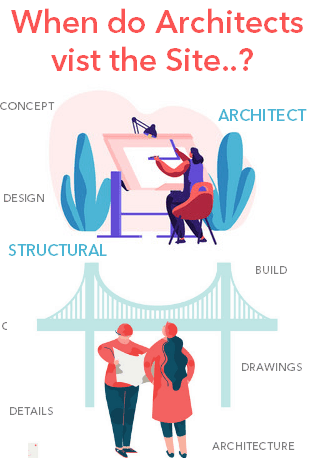 Construction is no easy work, even after getting the required working drawings to construct the residence.
Construction is no easy work, even after getting the required working drawings to construct the residence.
One needs to get the best Architects and Structural engineers' supervision to monitor the construction; A structural engineer will visit critical steel reinforcement checking.
These two professionals play a crucial role in ensuring that all the given workings drawings are followedas per the proposed Floor Plans and Elevations.
SUPERVISION by ARCHITECTS:
A good Architect will help the owner or Client recommend the best concept of house plans and then prepare detailed architectural working details.
In the process, making sure that the Client's dream of building his dream house is constructed right from Virtual concept to Reality to guide the Client to choose the best and affordable materials available in the market.
Also involved in site monitoring, Engaging different civil contractors, Project coordination, PMC, Estimates, Bill checking, etc.
The role of an Architect also involves continual revision of plans by client needs. Some of the include Meeting project deadlines, Time Management, Cost escalation, and other responsibilities depending on Project to Project as the project proceeds Stage by Stage, ensuring no delays and the planned works are well designed.
SUPERVISION by STRUCTURAL ENGINEERS:
A structural engineer supervises the construction work and involves Planning, Design implementation, Co-ordinate for structural implementation, Reinforcement checking, Site visits, etc.
While the construction is going on, he supervises, checks, and approves the construction's structural materials. He will also have the experience to test or suggest materials and structural integrity tests on the structure as a whole and declare whether the structure is safe or not.
Choosing the right CONSTRUCTION MATERIALS for Flooring/Bath Fittings/Electrical and more?
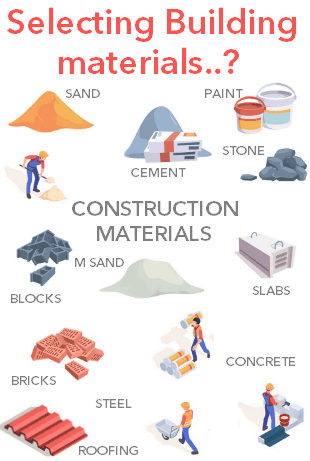 In Todays Modern Era, we have vast materials developed using new modern technologies for Better Living.
In Todays Modern Era, we have vast materials developed using new modern technologies for Better Living.
Architects are aware of the latest construction or building materials and their uses.
In changing times, people are moving towards Eco-friendly Designs/Materials for building their houses; in such cases, professionals are the right people to guide and implement their ideas.
One should know the below suggestions before selectingconstruction/building materials like Bath ware fittings, Flooring, Electrical fittings, Woodwork, Cladding materials, Sinks, Washbasins, Railings, Countertop, Paving, etc.
BUDGET:
Setting or Keeping a budget for each construction material before selecting it will help decide what to include in the project within the available Cost.
Once this is worked out, one can spend and subtract the amount of funding allocated to Construction, Bath ware, Flooring, Fixtures, Fittings, etc.
By following this, one will be assured that the project expense doesn't shoot up.
TIME:
Every construction material has its specifications for implementing/fixing it; some might finish faster, and others may end at a faster time. For example, considering Flooring Vitrified is the easiest to set and cost-effective, whereas Granite/Marble will take much more time as they require polishing work on site.
CONSTRUCTION WORK SEQUENCE:
Best Architects guidance involves getting all works done. Step by Step, which reduces redo tasks. In this step, a Building contractor must keep both the Architect and the Owner of the project in a loop about each work's progress at the site.
PERMISSION for ROAD CUTTING from BBMP for Laying Sewage Lines/Electrical?
It's necessary to get the required permission from BBMP for Road cutting for laying Sewage pipelines, Gas Lines, Telephone cables, the Internet, OFC cables, Electrical cables, Drainage lines, etc.
PROCEDURE followed for permission..!
To get permission to dig the road, the clients need to visit the authority's website, choose their zones from the portal, fill in the application, and detail the length, width, and pits required to dig up.
APPLICATION:
One needs to visit the website of BBMP and know the different zonal authorities. Then, one can download the right kind of Application form, which needs to be submitted with details such as Location, Length, Width.
SUBMIT & VISIT:
After applying the application online, the Details from the road cutting request will be sent to the respective zonal engineers of BBMP via Android phones. Then he visits the spot where the proposed road-cutting is planned, after which he proposes the horizontal trench or any other for digging.
FEES:
As per the current procedure, the applicant who requests the cutting permit will be asked a prescribed fee ranging from Rs 1200 to Rs 1500/mtr (per meter).
Sample: For a 40 ft road, the charges for digging the road would vary from Rs 16,000 to Rs 20,000. There might be additional charges that the authorities can charge if there are any damages to sanitary pipelines, water lines, etc.
TIME-FRAME:
This payment can be quickly paid to 33 different banks in the city by DD or online bank transfer. However, this entire procedure form will take a minimum of 7 to 10 days to complete.
The main reason that this process is carried out is to ensure that the road is repaired back to its normal state or original condition as it should not cause any disturbances/obstacles for the moment of Traffic.
Paying a FINAL BILL to the CONTRACTORS Approved by the Architects?
 Once the contractor submits the final bill towards the completion of the house construction of the proposed project.
Once the contractor submits the final bill towards the completion of the house construction of the proposed project.
This would be the final bill of the settlement between the Client and the Buiding Contractor with Bangalore Architects' help, ensuring that the final bill is cleared without hassle.
QUALITY CHECKS:
This would be followed by the Architects visiting the building site and cross-checking if the works are completed as per quality, schedule, and agreed-on specifications.
FINAL CHECK:
When the owner is paying the last " cheque of settlement "to the building contractor, both the Architect and the owner should go through the proposal's entire specifications and the completed work.
It's done to ensure that no pending work needs to be carried out or executed after paying the Bill.
NEGOTIABLE:
This final bill can be negotiable as the contractor has completed the entire works, but there can be a small margin for negotiation, given that both the Client and the owner agree.
RESOLVE IF REQUIRED:
Despite the best practices to Settle the final bill, if one comes to any disputes between them regarding the work carried on the site concerning the quality or work satisfactorily within the specified time.
It's always advisable to resolve the issue peacefully. If any rework needs to be carried out from these disputes, it's fitting that one can go for another agreement to settle the bill for the final work within the specified timelines.
A final bill to be Paid to satisfy both the parties can be mutually settled with the Architect or any third person as proof of settlement.
Procedure for APPLYING for New BWSSB WATER CONNECTION?
( BANGALORE WATER SUPPLY AND SEWERAGE BOARD ) BWSSB is a regulator government body that has the authority to sanction Water and Sanitary connections in Bangalore. Below is the complete process for getting BWSSB water and sanitary connection.
One can read detailed information on the BWSSB water connection in Bangalore and the charges. It's also explained in detail about Applying for Bwssb water connection, Documents required, Procedure involved, bwssb deposits, etc.
ELIGIBILITY OF THE APPLICANT:
When the house owner desires to have the water supply or the sanitary connection to their premises, they can get this service.
PROCESS:
As per Regulation 5.1, An applicant has to fill the application with Location details, Plan sanction copy, Endorsement for Road cutting given by BBMP/BDA, Photos of the applicant, OC (Occupancy Certificate) if Multi-storied building along with the filled application has to submitted to Assistant Executive Engineer coming to the respected zones of BWSSB.
After the Assistant Engineer or the Water Inspector inspects & recommends the file, AEE sanctions the domestic house service connections at the sub-division office.
Regarding multi-storied buildings that attract charges, the structure's measurement is taken, recorded & recommended by AE & AEE. Finally, the file is forwarded to the Executive Engineer or Additional Chief Engineer's office to sanction the file depending on the delegated power.
VISITS:
After submission, the authorized Water Inspector or Assistant Engineer (AE) will visit the site and recommend further processing. In the case of Domestic Residential/House connections, an AEE will sanction to provide the connection.
In case it's aMulti Storied building like Apartment complexes, Commercial structures will attract additional charges. These charges will depend on the measurement of the building, which AE or AEE measures. After this, it's sent to the Additional Chief Engineer or Executive Engineer to sanction the applied request and collect the required Fees.
FEES / CHARGES:
The total payable fees approximate up to 2040 rupees. Therefore, the DD given to activate the owner's service should favor the Chairman of the BSWSSB. The total fee of rupees in 2040 is the summation of various charges issued by the regulatory body.
The multiple charges are charged for Rs 850 as Meter Charges, Rs 315 as Minimum charges, Rs 600 for Sewage lines, Rs 25 for connection fee, Rs 250 as inspection fees.
DOCUMENTS REQUIRED :
- Sanction planned by BDA/BBMP/KIDB/BBMP or any government authority.
- (GBWASP) – Beneficiary Capital Contribution Receipt.
- Up to date tax paid receipt for the property.
- BBMP gives an endorsement for Road cutting.
- Address Proof: Like Electricity Bill, Telephone bill, Absolute Sale deed, Ration Card, etc.
Fixing SOLAR WATER Heaters and RAINWATER Harvesting?
 IMPORTANCE OF SOLAR WATER HEATER:
IMPORTANCE OF SOLAR WATER HEATER:
It's the simplest way to implement an eco-friendly solution at your House.
It would be just a one-time investment for endless returns by having a continuous hot water source without spending a rupee.
As one of the Top best residential Architects based in Bangalore, we propose different eco-friendly architectural solutions that are cost-effective and don't impact the overall proposed budget.
WHAT CAPACITY IS NEEDED:
One usually can get Solar water heaters in 50 lts, 100 ltrs, 150 ltrs, 200 ltrs, and higher capacities depending on the kind of requirement, whether it's for a Residential House or commercial building or large complexes.
Generally, for a 20×30 or 30×40 40×60 50×80 for G+1 or G+2 floors, one can opt between 100 liters to 250 liters again depending on the no of Houses or units built on the site.
HOW IT WORKS:
The whole heating water process to 60 to 80 degrees works by Solar radiation from the sun.
The sun rays fall on the Solar Panel inlaid with water tubes surrounded by steel foil or Water tubes connected to the water tank. One would also require an Overhead water tank, storing sufficient water to supply the water heaters.
IMPORTANCE OF RAINWATER HARVESTING (RWH) :
The Architects' proposal of providing Rainwater harvesting has to be planned at the very early stage while designing the House. It needs to be shown in the plan approval or blueprint drawings given to the authority for sanctioning.
HOW IT WORKS:
Generally, in today's scenario, where water requirements are higher than before, Natural water sources like Lakes, Wells, Rivers, Dams are used to deplete faster than ever before.
The groundwater level is depleting due to more than required utilization through bore wells. To retreat from the depleted groundwater table, one needs to implement Rainwater harvesting on-site, which collects all rainwater from the Terrace, Setbacks, Roofs, etc., piped through water filters drained into the soil.
It will gradually increase the groundwater table in the process of saving water for future generations.
Overall summary of Architects checklists for Building a House in Bangalore
- Site clearance: Making sure the Site is cleared of all debris and leveled to take accurate measurements.
. - Marking layout and excavation pits: Marking of footings, Columns, Plinth beam, etc., as per drawings given by the structural engineer.
. - Excavation for column pits: Digging up of soil up to hard stata as per the Structural engineer's recommendation.
. - Finishing the pits, dewatering, pest controlling: Verifying each foundation pit if it's given measurement and providing anti-termite or pest control treatment.
. - PCC: Plain Cement Concrete (PCC) for all Foundation pits.
. - Structural Reinforcement binding for footing according to design given by the Structural engineer.
. - Placement of formwork as per requirement, shuttering for footing as per reinforcement details.
. - Concreting for appropriate grade: Pouring right concrete mix proportions or grades such as M20 / M25 / M30 as per the given suggestion.
. - Removal of formwork: Once the concrete is poured, the foundation formwork can be removed after 24hrs.
. - Shuttering and Formwork for columns up to the plinth level.
. - Pouring of right concrete grade to the Columns.
. - Formwork removal after 24hrs and start curing of all columns.
. - Soil refilling for all foundations.
. - Laying one layer of Brick or Block to support the Plinth beam at ground level.
. - Plinth beam reinforcement as per structural design.
. - Plinth beams formworks as per requirement.
. - Pouring concrete into plinth beams.
. - Removal of formwork supports after 24hrs and curing the concrete.
. - Starting Brickwork / Blockwork from plinth level to Sill level (up to window bottom).
. - P.C ( Damp proof course) is done to prevent moisture from rising to the wall.
. - Filling of soil or construction debris and compacting up to the plinth level.
. - Bed concreting (1:4:5) up to the plinth level.
. - Extension of Steel reinforcement of columns above slab level.
. - Formwork for columns.
. - Filling of concrete of appropriate concrete grade for all columns up to lintel level.
. - Removing of Formwork after 24hrs and start curing.
. - Formwork for lintels as per drawing above all doors, windows, etc.
. - Reinforcement and Concreting for all lintels of ratio (1: 1.5: 3).
. - Formwork for Slab, Columns, and Beams as per structural details.
. - Reinforcement of Slabs, Beams, Staircase, etc., and Checking and getting approval from Structural engineer for concreting.
. - Electrical work at slab level as per Electrical drawings given by the Architects.
. - Concreting of Slabs, Beams as per the right thickness and grade as per details.
. - Removing of Vertical outer supports at slab and beams. Curing of concrete for a minimum of 21 days.
. - Formwork or Centring slab support removal after 22 to 30 days.
. - Starting Brick or Block Masonry work as per suggestion given by Architects.
. - Fixing for Door frames and Window frames.
. - Formwork and Concreting for Chajjas or window shades.
. - Curing of Brick or Blockwork masonry.
. - Grew cutting and Electrical work as per Electrical drawings.
. - Chicken mesh plastering at all junctions of Brickwork and concrete surfaces to avoid air cracks.
. - Plastering of all Internal walls.
. - Plastering of all Internal roofs.
. - Kitchen support or Kitchen counters slab casting.
. - Parapet wall construction as per Elevation drawing.
. - External plastering in two coats.
. - Flooring work (Granite/Vitrified/Marble).
. - Wall cladding work at Kitchen counter/ Washrooms, Utility, etc.
. - Waterproofing at Terrace.
. - Rainwater harvesting at Terraces and Balconies.
. - Fabrication work for Gates, Balcony grill, etc.
. - Internal painting with Putty + 2 Coat primer + 2 Coat Paint.
. - External painting with 2 Coat primer + 2 Coat Paint.
. - Solar water heater provision.
. - Fixing for Electrical switches and modules.
. - Door and Window Polishing.
. - Project handover.
Residential Architects in Bangalore.
1350 Square Feet House Design Drawing
Source: https://architects4design.com/
Belum ada Komentar untuk "1350 Square Feet House Design Drawing"
Posting Komentar